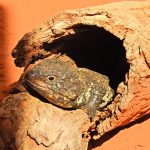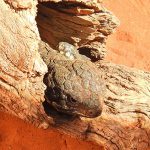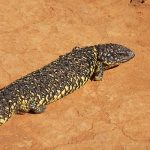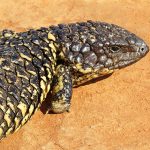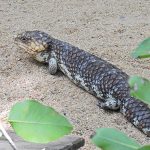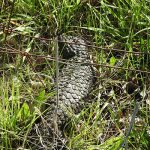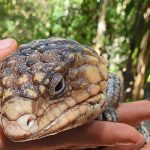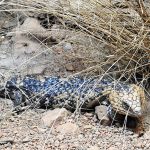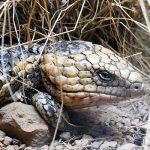SHINGLEBACK LIZARD
The Shingleback lizard is quite distinctive, with its robust, rounded body covered in large, rough scales that resemble shingles on a roof, hence its name. These scales provide excellent protection against predators and harsh environmental conditions. The lizard’s tail is short and stumpy, often resembling its head, which can confuse predators. They can store fat in their tails, which helps them survive periods of food scarcity. Its colouration varies from dark brown to cream, often with mottled patterns that help it blend into its surroundings.
Shinglebacks are found across southern and western Australia, inhabiting a variety of environments including scrublands, woodlands, and arid regions. They are well-adapted to dry climates and can often be seen basking in the sun on warm days.
While Shinglebacks are generally quiet creatures, they can produce a range of sounds, including hisses and grunts, particularly when threatened. These vocalisations serve as warnings to potential predators or rivals.
The Shingleback lizard is an omnivore, with a diet that includes a wide range of foods. They feed on insects, snails, flowers, fruits, and even carrion. Their strong jaws allow them to crunch through hard shells and fibrous plant material.
Shinglebacks are known for their monogamous nature, often forming long-term pair bonds that last for many years. Their strong pair bonds are unusual among reptiles, highlighting a fascinating aspect of their social behaviour. Breeding occurs in the spring, with the female giving birth to live young after a gestation period of several months. Typically, they have one to four offspring, which are quite large at birth, measuring about a third of the mother’s size.
These lizards are long-lived, with some individuals reaching over 20 years in the wild. Their slow metabolism and ability to store fat in their tails contribute to their longevity.
Currently, the Shingleback lizard is not considered threatened and is listed as Least Concern. However, habitat destruction and road mortality pose ongoing risks to their populations. Natural predators of the Shingleback include large birds of prey, snakes, and introduced predators like foxes, domestic and feral cats and dogs. Their tough scales and ability to hide in dense vegetation offer some protection. The Shingleback’s tail, which resembles its head, can confuse predators, giving the lizard a chance to escape.
The Shingleback lizard is a remarkable creature, perfectly adapted to its environment and showcasing unique behaviours that make it a fascinating subject for anyone interested in Australian wildlife. Through understanding and appreciating such species, we can foster a greater desire to protect and conserve these incredible animals and their habitats.


